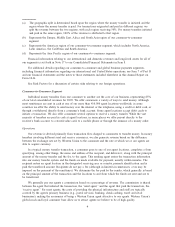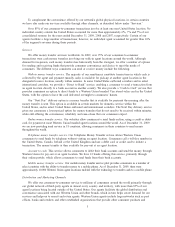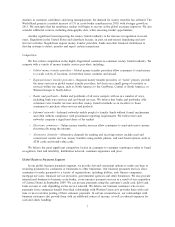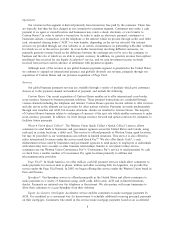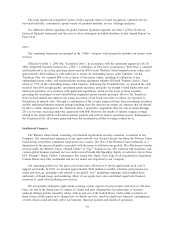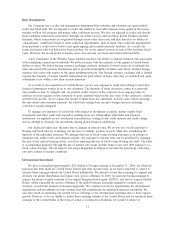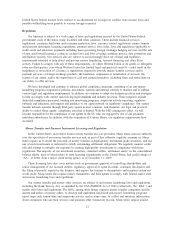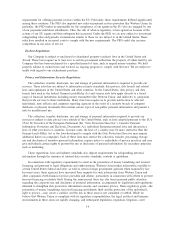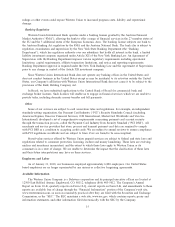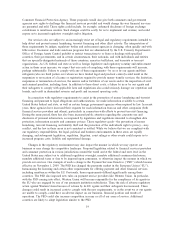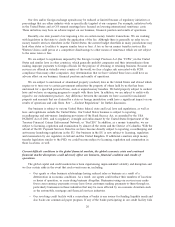Western Union 2009 Annual Report Download - page 25
Download and view the complete annual report
Please find page 25 of the 2009 Western Union annual report below. You can navigate through the pages in the report by either clicking on the pages listed below, or by using the keyword search tool below to find specific information within the annual report.Risk Management
Our Company has a credit risk management department that evaluates and monitors our agent-related
credit and fraud risks. We are exposed to credit risk related to receivable balances from agents in the money
transfer, walk-in bill payment and money order settlement process. We also are exposed to credit risk directly
from consumer transactions particularly through our online services and electronic global business payment
channels, where transactions are originated through means other than cash, and may therefore be subject to
“chargebacks,” insufficient funds or other collection impediments, such as fraud. Our credit risk management
team performs a credit review before each agent signing and conducts periodic analyses. As a result, our
losses associated with bad debts have been less than 1% of our annual revenue in each of the last three fiscal
years. However, the recent global economic crisis may increase our losses associated with bad debts.
A key component of the Western Union business model is our ability to manage financial risk associated
with conducting transactions worldwide. We settle accounts with the majority of our agents in United States
dollars or euros. We utilize foreign currency exchange contracts, primarily forward contracts, to mitigate the
risks associated with currency fluctuations and to provide predictability of future cash flows. Limited foreign
currency risk arises with respect to the agent settlement process. The foreign currency exchange risk is limited
because the majority of money transfer transactions are paid within 24 hours after they are initiated and agent
settlements occur within a few days in most instances.
As a result of our acquisition of Custom House, we are now exposed to credit risk relating to derivative
financial instruments written by us to our customers. The duration of these derivative contracts is generally
nine months or less. To mitigate risk, we perform credit reviews of the customer on an ongoing basis. In
addition, we may require certain customers to post collateral based on the fair value of the customer’s contract
and their risk profile. As we require the receipt of funds from our customers, in most cases, before releasing
the associated cross-currency payment, the credit risk arising from our spot foreign currency exchange
contracts is largely mitigated.
To manage our exposures to credit risk with respect to investment securities, money market fund
investments and other credit risk exposures resulting from our relationships with banks and financial
institutions, we regularly review investment concentrations, trading levels, credit spreads and credit ratings,
and we attempt to diversify our investments among global financial institutions.
Our financial results may fluctuate due to changes in interest rates. We review our overall exposure to
floating and fixed rates by evaluating our net asset or liability position in each, while also considering the
duration of the individual positions. We manage this mix of fixed versus floating exposure in an attempt to
minimize risk, reduce costs and optimize returns. Our exposure to interest rates can be modified by changing
the mix of our interest bearing assets, as well as adjusting the mix of fixed versus floating rate debt. The latter
is accomplished primarily through the use of interest rate swaps and the terms of any new debt issuances (i.e.,
fixed versus floating). We use interest rate swaps designated as hedges to increase the percentage of floating
rate debt, subject to market conditions.
International Investment
We have accumulated approximately $2.0 billion of foreign earnings at December 31, 2009, for which no
provision has been made for United States federal and state income taxes, as we have reinvested or expect to
reinvest these earnings outside the United States indefinitely. We intend to invest these earnings to expand and
diversify our global distribution and explore new service offerings. In 2009, we used our foreign earnings to
acquire the money transfer business of our largest European-based agent, FEXCO, and also to acquire Custom
House, which expanded the service offerings of the global business payments segment to include cross-
currency, cross-border business-to-business payments. We continue to look for opportunities for international
acquisitions and investments in joint ventures that will complement our existing businesses worldwide. We
may also invest in expanding our current service offerings or our international operating sites to drive organic
growth. However, if we are unable to utilize these earnings outside of the United States and we repatriate these
earnings to the United States in the form of actual or constructive dividends, we would be subject to
11





